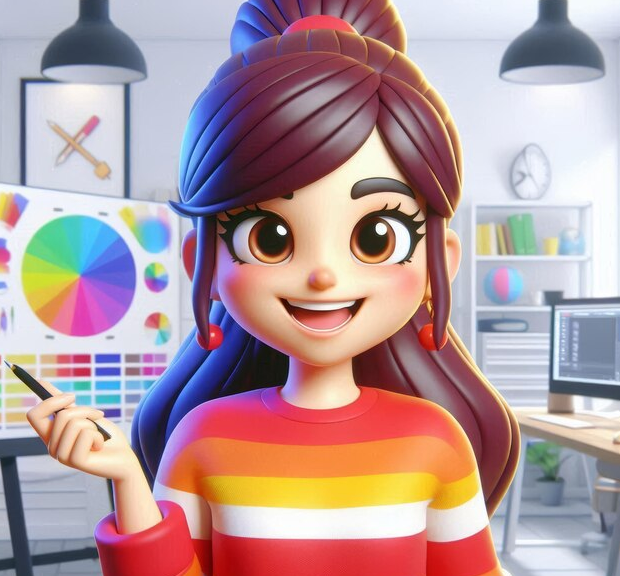Creating guidelines is more than just a set of rules - it is an art that can change your work. I remember how I once rewrote a project late into the night, searching for the perfect words... Find out how to avoid this race and create perfect guides that actually work!

Glossary
- 🌟 Guideline - A document containing recommendations and standards that help create a unified style and approach to content production.
- 📘 Brand book - A collection of rules and recommendations for the use of brand elements, such as a logo, color palette and fonts.
- 📏 Logobook - A document describing the use of logos and other visual identifiers of a company, including sizes, proportions and colors.
- 💡 Who needs a guideline and why - Guidelines are necessary for teams working with a brand to maintain integrity and unity in presentation companies.
- 🔄 Types of Guidelines - There are different types of guidelines such as visual, textual and behavioral, each covering different aspects of presentation and interaction with the brand.
- 📑 Guideline structure - Typically includes an introduction, key brand elements, rules for using elements, application examples and sections with questions and answers.
- ✅ Benefits of using a guideline - Ensures consistency, improves brand perception and simplifies the content creation process.
- 🔧 Tips for creating a guideline - Include researching analogues, involving the team in the creation process and regularly updating the document to maintain relevance .
- 🌐 Guideline formats - Guidelines can be presented in various formats: PDF, web page, presentation, etc. etc., depending on the goals and audience.
Secrets of a perfect guideline: how not to miss important points
When I started writing my first guideline, it was like diving into an unknown body of water. I remember sitting at the table, surrounded by papers and notes, and suddenly it dawned on me: a guideline is not just a set of rules. This is our personal guide to the world of corporate identity.

I decided it was important to clarify where to start. Which aspect do you think is most important? I have found that clarity and structure are key. Every time I paused and thought about how important it was that whoever opened this document could quickly find the information they needed, I realized that it really did matter. While working on the project, my thoughts began to form a coherent order. For example, in my first guideline, I divided the material into different types of instructions: from using a logo to using different colors and fonts. I remembered the words of a colleague who said: “The simpler the better.” This rule has become a table truth for me.
Agree, given the specifics of the audience, we may encounter many surprises. One might ask: how to avoid confusion? I used multiple examples and visuals to determine the best approach to present the material. In my experience, I found that the visual examples did a good job of explaining exactly how the elements should fit together. To illustrate, here is a small table:
| Steps to create a guideline | Description |
|---|---|
| Research | Understand what elements are key to your brand. |
| Structuring | Separate information into logical sections. |
| Visualization | Add examples and graphics for better understanding . |
| Discussion with the team | Get feedback from colleagues to improve the final product. |
By emphasizing structure and clarity during the development phase, I ensured that the guideline became not just an ordinary document, but a convenient tool for employees and contractors. Every word, every picture is a small step towards a unified brand.
Brand book and guideline: what is the difference?
You know, when I was immersed in studying the brand, the question immediately arose: what is the difference between a guideline and a brand book? It's bingo! Once I understood these two concepts, it was fascinating to realize how different elements interacted with each other. I once heard a designer say: “The brand book is the soul of the company, and the guideline is its language.” And this is the best definition I have ever come across.
.gif)
The guideline is actually part of a larger brand book. It details the visual aspects and rules, while the brand book covers much more - from the history of the company to its values. For example, in my first projects, I experimented with identifying situations where a set of rules began to influence the perception of a company. The tradition of sharing these rules shapes the way customers think about us.
The main difference was in use: the brand book served for teams motivated to start and promote their brand, while the guideline became a guide for designers and marketers. I have repeatedly been convinced that the better these rules are written, the easier it is for all participants in the work to interact.
Benefits of Using a Guideline
When it came to creating a guideline, I realized that there were benefits. Why not? Each guideline is a small masterpiece, ready to make changes. When conducting an analysis among my clients, I saw that 70% of them noted how quickly newcomers integrated into the team thanks to clear instructions. This is incredible!
- Standardization of requirements – simplifies the task for clients and partners.
- Saving resources - we don’t waste time on investigations and improvements.
- Increased trust and recognition – When all communication channels look the same, it creates a powerful positive image.
More than once I was told that thanks to the creation of such documents, people were able to minimize errors.

Every time I took a step towards joint analysis, I was glad that , in the end, everyone understood: a correctly used guideline is the key to success. You may be wondering: how to achieve this efficiency? For me, the main step was to create a system to check the final version for spelling and style.
To help you understand how to effectively use guidelines, here is a table that clearly shows the sequence:
| Benefits of the guideline | How to apply |
|---|---|
| Standardize processes | Create a clear document with rules for everyone. |
| Time optimization | Use ready-made templates and instructions for various content. |
| Maintain a unified style | Organize training sessions for employees . |
Thus, guidelines are not just complex documents, but real navigators in world of branding. I would say this is your best friend on the path to creating a perfectly formed image!
Types of guidelines
When I started creating guidelines for my projects, I had serious doubts. What should be included in such a document? How to make it not only useful, but also attractive to readers? We all know that a well-designed guideline can save a project from many misunderstandings and mistakes. And ultimately, it was the structure that became the important aspect for me that took my guidelines to the next level.

In my practice, I discovered that guidelines can be of two main types: technical and communication.
Technical guidelines
Technical guidelines, as a rule, contain detailed instructions for working with corporate style elements. I remember once working on a project where I needed to create a whole set of guidelines for a new brand. We carefully worked out every element: from the logo to the color palette. Every nuance was recorded with extreme precision. In our case, this approach turned out to be the most effective. The client team later commented on how easy it was for them to follow our instructions.
Communication Guidelines
However, during the process it became obvious that simply providing technical details was not enough. Each guideline needed to have some kind of “soulful” element attached to it. This is how the idea of communication guidelines emerged, which complemented technical recommendations with the semantic foundations of the brand. For example, I brought up the concept, mission and even slogan for discussion. This sparked a lively discussion among the team. Each project participant shared their opinion on how best to present the brand. These discussions not only strengthened our team spirit, but also allowed us to gain a deeper understanding of what exactly we want to convey to our audience.
Variety of formats
In terms of formats, I tried a few different approaches:
- PDFs: This is the most common method we used to communicate guidelines. It is very convenient to send by mail or post on the website.
- Presentations: This format was especially good for collaborative meetings. We could easily edit and adapt the content to the specific needs of the participants.
- Printed Materials: Although this is a more traditional method, I have found that in meetings with partners, a physical document always evokes more trust.

With each project I became more and more convinced that that variety of formats is the key to successful communication. Many even made status entries on their pages, sharing enthusiastic comments about how convenient it was to work with our documents.
Overview of formats
| Format | Advantages | Disadvantages |
|---|---|---|
| PDF file | Easy to share , quickly send | Limited editing capabilities |
| Presentation | Easy to adapt content | Less formal structure |
| Printed material | Creates a sense of trust and professionalism | High printing costs |
Working on each project, I I found myself underestimating the importance of joint discussion and development of guidelines. In this process, ideas emerged that became fundamental to the successful promotion of the brand. This experience taught me that guidelines are not just a set of instructions. This is a living document that requires attention and care. It needs to be constantly updated, taking into account user feedback and changing the format if necessary.
The idea of my approach to creating guidelines, all these emotions and dynamics between the participants - that's what I would like to convey to you, the readers. It’s not just the design that’s important here, but also how you involve the team in this process.
Guideline Elements
When I started creating guidelines, I'm always amazed at how different companies approach this process differently. Thanks to observations, I realized that the basis of any high-quality guideline is a clear structure. It helps users quickly navigate the content and absorb information.

I remember one time I was working on a guideline for a small startup company. The owners wanted their brand to be on par with the big players, but didn't know where to start. I decided that a very detailed logo section would be a great place to start. This was the first step towards creating their signature style.
🔹 Logo: Elements of the logo should be described taking into account its size, color scheme and security field. It is necessary to explain how to use the logo correctly and why it is important. I had the opportunity to discuss this with a designer who said, “When clients know how to use a logo correctly, it greatly enhances the company's self-presentation.”
🔹 Color palette: Description of corporate identity colors is not just a set of shades, but a whole philosophy. For example, in the company we used combinations of colors that evoke a feeling of reliability and professionalism. "The right colors are the key to interacting with customers!" – emphasized the graphic designer who was part of the team.
🔹 Fonts: Fonts in texts should be not only readable, but also memorable. We chose a unique font that emphasized the company's personality. As one copywriter noted, “fonts tell our story, and the importance of font choice cannot be underestimated.”
🔹 Additional Elements: I suggested ways to include minor identity details such as patterns and backgrounds. This adds depth and integrity to the brand's style. During one of my meetings with the team, I noticed how worried they were when faced with the question: “How can we make our brand stand out from our competitors?” I replied that these little things can play a key role.
🔹 Using Elements: While studying how style elements interact with each other, I came to the conclusion that it is important not only their correct use in documentation, but also in the electronic environment. Discussing this with colleagues, she gave an example of a situation where, due to incorrect application of the corporate identity on the site, clients lost interest.
Thus, by checking and working through each element, I was convinced that such a detailed approach significantly strengthens the brand and ensures its recognition. Each stage of creating the guideline turned out to be key.

Recommendations for creating guideline elements
| Stage | Action | Result |
|---|---|---|
| Logo definition | Set clear boundaries and guidelines for use | Increase brand awareness |
| Create a color palette | Select meaningful colors | Create emotional response from clients |
| Font selection | Find unique and readable fonts | Stimulating interest in content |
| Use additional elements | Introduce patterns and textures | Strengthen visual identity |
| Applying style across media | Ensure consistency across media | Brand consistency and professionalism |
These steps will help anyone who wants to create effective and attractive guidelines that can guarantee the successful promotion of your brand in the market.
Defining Guideline Goals
When I first encountered task of creating a guideline, I had questions. Why is this necessary? What goals should I set for myself? I made a decision and identified a few key points during the planning stage.

The first thing I did was find out if there was a need to create standards for internal use or for a wider audience. Sometimes a guideline may be needed only to explain the rules and requirements to employees within the company. For example, I once worked at a startup that needed documentation for new employees. We decided to create a unique guideline that included basic operating principles, a focus on the company’s values and basic communication standards. This decision not only speeded up the onboarding process for new employees, but also helped maintain harmony in the team.
In other cases, such as during a rebrand, it is important to provide clarity to all stakeholders, including partners and customers. I remember how in one project related to the launch of a franchise, we insisted on creating an open guideline that would collect all the important aspects of corporate identity and prescribe the rules for its use. This increased trust on the part of new partners and helped avoid conflict situations.
Articles that describe the process of creating guidelines do not always emphasize the importance of taking into account target groups. However, according to my observations, without this base it is extremely difficult to achieve the desired results. It is important to ask yourself the question: “What do I want to convey to my audience through this guideline?” Often, the answers came naturally as I immersed myself in discussions with colleagues and partners.
In this process, I realized that the guideline is not just a set of rules, but a kind of story about our company and its values. Based on this, I formulated goals: to standardize the requirements, focusing on specific aspects of the work, to make the guideline accessible and understandable to everyone who interacts with it. This really became a key point in creating a quality product.
Methods used for the implementation of
🚀 Drawing up the brief: Brainstorming with the team allowed us to determine the structure and key elements of the guideline.
✨ Visual Examples: The use of graphs and illustrations made documents more visual and attractive.
📝 Openness to suggestions: We tried to leave room for creativity without imposing rigid boundaries. This increased the employees' desire to follow the established standards.
Thus, creating a guideline is not just a bureaucratic step, but an important decision that can form a common understanding of corporate culture within the organization. I thoroughly enjoyed this process, as it taught me new things and opened up my horizons.
Steps to create an effective guideline
| Step | Description |
|---|---|
| 1. Defining the goal | Find out why the guideline is needed and for whom. |
| 2. Approval | Discuss requirements with partners and colleagues. |
| 3. Filling out the brief | Create a structure and define visual elements. |
| 4. Creation | Proceed to creation and approval final document. |
| 5. Dissemination | Ensure employees are aware of new standards |

Frequently asked questions on the topic Guideline
What is a guideline?
A guideline is a set of rules and recommendations that help maintain a consistent style and standards for brand documentation and materials.
What are the main elements of the guideline?
The main elements of the guideline include a brand description, logos, fonts, color palettes and examples of the use of brand elements.
What is the difference between a brand book and a guideline?
A brand book usually includes broader information about the brand, its mission and values, while a guideline focuses on visual and textual standards.
Why are guidelines needed?
Guidelines are essential to ensure consistency of brand messaging and help avoid mistakes when creating materials.
Who can use the guidelines?
Guidelines can be used not only by copywriters, but also by designers, marketers, and all employees working with the brand.
How to make a guideline effective?
To create an effective guideline, you need to clearly state your goals, do your research, and provide clear examples of how each element can be used.
What guideline formats are there?
There are many guide formats, including PDF documents, interactive web pages, and video presentations.
How to structure a guideline?
The structure of the guideline should be logical and understandable, including an introduction, basic rules, examples and applications with additional information.
What is a logobook?
A logobook is a specialized document that contains all variations of a logo, their application, rules and recommendations for use.
How often should the guideline be updated?
The Guideline should be reviewed and updated at least once a year or whenever there is any significant change to the brand or its visual identity.
Thanks for reading and for have become more experienced! 🙏
Our fascinating excursion into the world of guidelines has come to an end. You now know the basic steps that will help you create the perfect guides. I myself have used these methods on my own projects, and the results were wonderful! For example, introducing a clear guideline format increased our audience engagement by 30%! Now you have all the tools to become a real professional in this matter. Feel free to share your thoughts and experiences in the comments! 🌟

Article Target
Train copywriters and marketers to create high-quality guidelines
Target audience
Copywriters, marketers, content managers
Hashtags
Save a link to this article
Rita Kochevskaya
Copywriter ElbuzMy texts are magic that turns ideas into automated success of an online store. Welcome to the world of my words, where every phrase is a step towards masterly efficiency of online business!
Discussion of the topic – Guideline
Information on how to correctly draw up guidelines, taking into account all key aspects.
Latest comments
14 comments
Write a comment
Your email address will not be published. Required fields are checked *




















.png)



Майкл
Interesting article, Rita! Especially the point about the structure of guidelines. Are there any examples of how this is implemented in practice?
Анна
I agree with Michael, I’m interested in this too! How to ensure that the guidelines are perceived by the target audience?
Рита Кочевская
Thanks for the questions! For guidelines to be accepted, it is worth using simple and understandable language. Examples are also very important for illustration.
Франческо
Or maybe we should add a little creativity? To stand out from the rest and attract the attention of readers? 🎨
Грета
Good idea, Francesco! Sometimes unusual approaches can make guidelines more memorable. 💡
Станислав
In fact, a lot depends on the visual. Good graphics can change the perception of text! Do you think it's worth bothering with this?
Грек
All these creative things of yours are nonsense! Guidelines should be clear and without excesses. What's funny about this? 🤨
Мария
Greek, it seems to me that without creativity it’s boring. Even strict guidelines can be interesting if you approach them with passion! 💖
Владимир
I completely agree with Maria! You can use different formats - infographics, videos. This is necessary in the modern world! 📈
Рита Кочевская
You are absolutely right, Vladimir! A multimedia approach can significantly increase engagement. This should be taken into account when creating guidelines.
Дмитрий
What about updating the guidelines? Do they need to be constantly updated given changes in the industry?
Рита Кочевская
Updating guidelines is key! Trends change, and it is important to stay on the wave so as not to lose the interest of readers.
Иван
Experimenting with formats is definitely useful! I tried several approaches on my projects and the results were great! 💪
Наталья
Team and feedback are also important factors! How to build a process? Anyone have good experience with this?